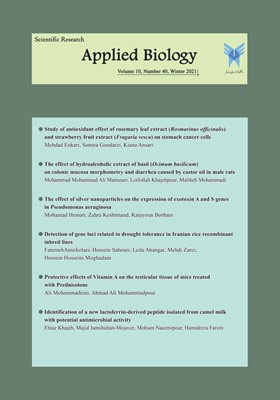-
-
List of Articles
-
Open Access Article
1 - Study of antioxidant effect of rosemary leaf extract (Rosmarinus officinalis) and strawberry fruit extract (Fragaria vesca) on stomach cancer cells
Mehdad Enkari Samira Goodarzi Kiana Ansari -
Open Access Article
2 - The effect of hydroalcoholic extract of basil (Ocimum basilicum) on colonic mucosa morphometry and diarrhea caused by castor oil in male rats
Mohammad Mohammad Ali Mansouri Lotfollah Khajehpour Maliheh Mohammadi -
Open Access Article
3 - The effect of silver nanoparticles on the expression of exotoxin A and S genes in Pseudomonas aeruginosa
Muhammad Hemati Zahra Keshtmand Katayoun Borhani -
Open Access Article
4 - Detection of gene loci related to drought tolerance in Iranian rice recombinant inbred lines
Fatemeh Amirkolaei Hossein Sabouri Liela Ahangar Mehdi Zarei Hossein Hossein Moghaddam -
Open Access Article
5 - Protective effects of Vitamin A on the testicular tissue of mice treated with Prednisolone
Ali Mohammad Eini Ahmad Ali Mohammadpour -
Open Access Article
6 - Identification of a new lactoferrin-derived peptide isolated from camel milk with potential antimicrobial activity
Elnaz Khajeh Majid Jamshidian Mojaver Mohsen Naeemipour Hamidreza Farzin
-
The rights to this website are owned by the Raimag Press Management System.
Copyright © 2021-2025







